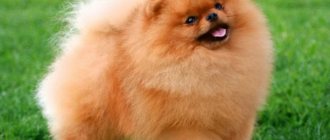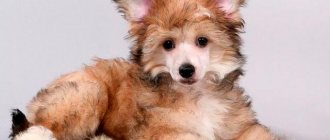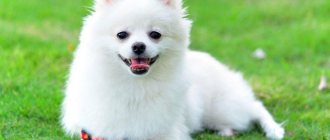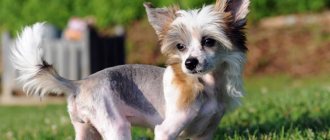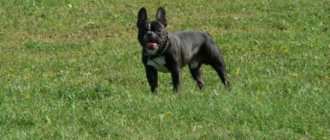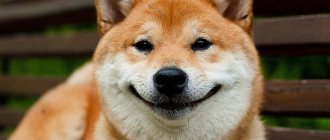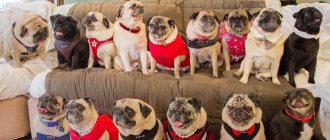Breed traits
Breed traits (on a 5-point scale)
| Miniature Poodle (Miniature Poodle) | |||
| Activity | in the house | 3.2 | |
| on the street | 3.3 | ||
| Obedience | training | 4 | |
| strangers | 4 | ||
| Domination | in family | 2 | |
| over dogs | 2.6 | ||
| Defending your territory | from people | 3 | |
| from dogs | 3 | ||
| Sociability | in family | 4.8 | |
| with strangers | 3.7 | ||
| with dogs | 3 | ||
| Concentration | in family | 1 | |
| in front of strangers | 1.8 | ||
| with dogs | 1.5 | ||
| Aggressiveness | in family | 1.2 | |
| to strangers | 1.4 | ||
| to the dogs | 2 | ||
| to cats | 2 | ||
| Family behavior | calmness | 4.5 | |
| demand for affection | 5 | ||
| excitability | 4.2 | ||
| playfulness | 4.6 | ||
| excessive barking | 2.7 | ||
| behavioral breakdowns | 1.5 | ||
| Tolerance for children | up to 4 years | 4 | |
| over 4 years old | 4 | ||
| Institutional use | watchman | 4 | |
| bodyguard | 2 | ||
This breed is often compared to the following dog breeds: Yorkshire Terrier, English Cocker Spaniel, Maltese (Maltese Bichon), Bichon Frize, Finnish Spitz.
The photo shows what miniature poodles look like:
General characteristics of the breed
Poodles are a popular and well-recognized breed all over the world. They perform in the circus and perform complex stunts. These dogs are very smart, quick-witted, love to learn and serve people. But their main feature is their original appearance. Dogs of this breed have fluffy long hair and they have different haircuts.
Now the poodle breed is known in four varieties: standard, medium, miniature and toy. They differ in height and weight. The miniature or miniature poodle is the most popular option for keeping at home. This is a cheerful, playful and very smart pet. He gets attached to his owners and is good with children. These dogs are smaller in size than the medium or small poodle, and differ from the toy in better health and endurance.
| Options | Characteristic |
| breed name | toy or miniature poodle |
| country of origin | France |
| year of registration | 1840 |
| group of breeds according to the ICF classification | decorative and companion dogs, poodle section |
| usage | companion, circus dog |
| life expectancy | 12-15 years |
| height | 28-35 cm |
| weight | 4-7 kg |
| aggressiveness | not aggressive, friendly with everyone |
| activity | active, mobile |
| intelligence | tall, easy to train |
| care | complex grooming |
| health | weak |
pros
Dwarf poodles were not always popular, unlike their royal ancestors. But recently interest in them has increased. This is due to the extraordinary appearance of these dogs and their high intelligence. In the ranking of the smartest dogs compiled by Dr. Coren, poodles take 2nd place. They have several more advantages:
- due to their small size, they easily get along in a small apartment;
- suitable as a first pet, not prone to dominance;
- they are easy to learn, even children can train them, they quickly learn commands;
- very artistic, easily learn tricks, can perform in the circus, participate in dog sports;
- cheerful, cheerful, good-natured, peaceful;
- sensitive, understand the owner’s mood, easily adapt to his habits;
- get along well with children and other pets;
- almost do not shed, do not have a dog smell, so they are suitable for people with allergies;
- with proper care, these dogs live a long time;
- complete absence of aggression.
Minuses
Don’t think that because of its attractive appearance it will be an indoor toy dog. The poodle has character, it is a serious dog. His ancestors were hunting gun dogs and worked as rescuers and watchmen. Therefore, the breed is not suitable for those who need a decorative dog, it is more of a companion. There are a few other downsides that can create maintenance problems.
- Difficult coat care. It needs to be combed and trimmed regularly. You will have to buy tools and learn the rules of cutting or visit a hairdresser.
- This is a very active, inquisitive pet. He needs to be walked for at least 2 hours a day. When walking with your pet, you need to exercise: run, play, train.
- If you don't give your dog attention and don't give him an outlet for energy, he can become nervous and irritable. These poodles behave restlessly.
- Representatives of the breed are very emotional and express their emotions with their voice. Their bark is loud, which can create problems in an apartment building.
- Poodles do not tolerate change well; they do not like noise or a nervous environment in the house. They become very attached to their owner and cannot get used to the new owner.
- These dogs need attention. When alone, they feel sad and can become depressed.
pros
Buying a dog is a responsible step. You must familiarize yourself with all the breed characteristics and weigh the pros and cons. First, let's look at the advantages of the breed:
- Intelligence : Poodles rank second among the ten smartest dog breeds in the world.
- Obedience : the authority of the owner for the poodle is unshakable.
- Do not shed : Poodle hair does not settle on clothes, furniture and carpets.
- Health : strong immunity and endurance make poodles long-lived.
History of the origin of the Miniature Poodle breed
Dwarf representatives of the breed were bred only in the 19th century, although large poodles have been known since ancient times. These dogs helped people hunt, they were used in patrol and search service, and in war. But gradually, due to their attractive appearance, they increasingly began to be kept as a decorative pet. They became popular among rich people.
But the standard poodle is too tall, so breeders developed a dwarf version of the breed. The emphasis was not on working qualities, but on appearance. The mini-version was bred by the Swiss scientist Shaitlin. The first breed standard was approved in France in 1880.
This variety became popular only in the 20th century. Although during the Second World War, interest in dwarf dogs faded. But in the 60s, breeders began breeding again, and at that time representatives of the breed appeared in Russia. Nowadays, toy poodles are one of the most popular decorative dogs.
Application
Poodles once served successfully as hunting dogs. Today they have become mainly companions for glamorous ladies and wonderful pets for people of different ages. Due to their keen intelligence and high trainability, these dogs are often used in circus performances and various shows.
The poodle can be a bodyguard, but this breed is not suitable for guarding the house.
An energetic and strong animal will become an excellent athlete, and you can practice freestyle or agility with him.
Description of appearance
The miniature poodle is a smaller copy of the standard representative of the breed. He has retained all the proportions of his body, and unlike toys, they do not have signs of dwarfism. The height of an adult miniature is 28-35 cm. The dog weighs 4-7 kg. Deviations from these parameters are not recognized by the standard and apply to other varieties of poodles.
Puppies grow until they are about 6-7 months old. At this age you can understand whether the dog will meet the standard. Then they gain a little height and weight, reaching their maximum weight by the age of one year.
Head
The head is of the correct shape, proportional to the body. The occipital protuberance is moderately pronounced, the stop is smooth. A feature of the breed is a longitudinal groove that runs from the back of the head to the back of the nose. The muzzle is elongated, but not narrow. The jaws are well developed, fit tightly together, and have a scissor bite. The teeth are strong, pure white in young dogs, but may darken with age.
The nose is medium, the nostrils are wide. Black in color; in red and apricot dogs it can be brown. The eyes are almond-shaped and slightly oblique. Amber or brown depending on coat color. The ears are wide, soft, hanging. They fit to the head, the lower edge reaches the lips.
Frame
This dog has a strong, harmonious build. Unlike Toy, they have no grace. The body format is rectangular - the length is greater than the height at the withers. The neck is of medium thickness, the scruff is well defined. The chest is wide, reaching the elbow joints. The abdomen is moderately tucked. The back is short and straight, tapering towards the loin, the croup is rounded.
The tail is without bends, set high. It does not fall over the back, but when the dog moves, it lifts it, it takes on a saber shape. Some breeders dock the tip of the tail, but it should not be very short.
Limbs
The limbs are straight, muscular, but not wide. Placed in parallel. The hock joints are well defined. The paws are small, the toes are compactly collected. The gait is light and springy.
Coat and colors
The hair of dwarf poodles is thick and fluffy, similar in structure to human hair, without undercoat. It can be of two types. The first is more common - these are soft, wavy hairs. The wool is voluminous and springy to the touch. The second type is corded. Wool consists of long twisted cords. It is tougher and denser.
The color of the poodle should be uniform, without spots or inclusions of other colors. It is fully formed only by the age of 12 months. In an adult dog, color saturation or hue may change. The standard provides several color options:
- black;
- white;
- brown;
- red in different shades - apricot, peach, red;
- grey.
Rare colors not recognized by the FCI are harlequin and tan. These dogs are bred in Russia. Harlequin is a white dog with a black head and a blanket on his back. Tan dogs may have a background color of black, red, brown or grey. 20% of the body is occupied by fur of a different color, usually on the chest, muzzle, and paws.
Photos complement the description of the appearance of these dogs:
Varieties of colors
The standard for representatives of the dwarf poodle breed allows several solid colors: black, apricot, peach, brown (any shade), silver (gray) or white. Since 2007, the color has been recognized as brown-red (red).
In the Russian Federation and a number of other countries, the tan color (phantom) and harlequin are adopted as standard. Miniature poodles with such a rare color are more expensive than solid ones.
Character and education of Miniature Poodle dogs
The character of this dog combines aristocracy and restlessness. Unlike royal poodles, dwarf poodles are more mobile and active. This is a cheerful, playful animal that treats everyone kindly. The dog becomes attached to the owner and his family members, loves children, can be wary of strangers, but does not show aggression.
This breed is suitable for both single people and large families with school-age children; young people and old people find a common language with it. All poodles are empaths, they feel the mood and psychological state of the owner, and are always ready to calm and cheer. If a person is not predisposed to communication, the dog will not impose itself. These pets easily adapt to the owner’s lifestyle and can adopt his habits and repeat his behavior.
Another important feature of the character of a dwarf poodle is that it needs constant communication with a person. These dogs love to be the center of attention, they like to be praised and petted. Therefore, poodles are happy to perform in various shows and in the circus. These are inquisitive, cheerful dogs, they never sit still, follow their owner’s heels, and participate in all activities.
Negative character traits include excitability, jealousy and vulnerability. This distinguishes dwarfs from large poodles. They are very sensitive, emotional and impressionable. They bark loudly from excess feelings. They do not tolerate rudeness well and do not tolerate being shouted at. These dogs can be unbalanced, irritable, and fearful. They are highly susceptible to stress.
Dog experts do not recommend having a miniature poodle for families with small children. Due to its small size, this pet is fragile and a child can hurt it. In response to this attitude, the dog may develop mental problems.
Features of training
The Miniature Poodle is one breed that is suitable for inexperienced owners. These are very smart, obedient dogs, they love to learn and quickly learn commands. Therefore, even a child can train them. The main thing is to follow a few rules:
- Early socialization is important for a puppy, without which he can grow up fearful and aggressive;
- You can’t behave rudely, shout at the dog, it will withdraw and stop obeying;
- Encouragement and affection are required;
- training should take place in the form of a game; poodles need new experiences.
Sometimes dog handlers recommend building the training process like a circus performance. Let someone watch the dog, clap and admire. Poodles love this very much.
Maintenance and care
Dwarf poodles are unpretentious and adapt to any conditions. You need to provide your pet with a place in the house to sleep and eat. It is recommended to buy a lot of different toys so that the dog does not get bored in the absence of the owner. Despite its compact size and the ability to train it to go to the toilet in a diaper, this dog must be walked 2 times a day. She needs active games and new experiences.
Hygiene procedures for caring for a poodle are the same as for other dogs. It is necessary to regularly examine and clean the eyes, ears, trim the nails and brush the teeth. It is not recommended to bathe your pet often; 1-2 times a month is enough. Be sure to use a special hypoallergenic shampoo. Wash your paws and belly every time after a walk. You need to brush your pet several times a week, this will help prevent tangles and ensure an attractive appearance.
A haircut
The peculiarity of caring for a poodle's coat is that it needs to be cut. It is recommended to do this once every 1-2 months. Grooming will help prevent the dog's fur from becoming matted and overheating in hot weather. Removing hair on the paws, belly, and under the tail makes it easier to maintain cleanliness. If the poodle is being exhibited, it is better to visit a hairdresser. But many owners give their pets their own haircuts; to do this, they need to purchase special scissors and a clipper.
When choosing, you need to make sure that the tools are designed for poodles. Due to the nature of the coat, standard clippers are not suitable for wire-haired dogs. You will need long and short scissors. The blades should have small notches; they prevent the hair from slipping out and make the haircut smoother.
The standard allows several types of hairstyles for a poodle: lion, English, modern and bikini. But if the dog will not be shown, you can cut it however you like. There are different exotic options that give the poodle an original look.
Photos of different haircuts for miniature poodles:
Nutrition
The dwarf poodle is unpretentious in food. You can feed him prepared food or natural food. Just don’t mix these two types of food. Ready-made food includes not only dry granules, but also canned food; they must be of the same brand.
For dogs of this breed, super-premium or holistic options are suitable. They contain a balanced amount of microelements, proteins, fats and carbohydrates, and do not contain grains or synthetic additives. The best dry food for a miniature poodle: Acana, Farmina Natural&Delicious, Grandorf, Almo Nature, Brit Care, 1-st CHOICE.
With natural feeding, you need to properly formulate the diet so that the pet gets everything it needs. It should consist of the following products:
- meat – beef, turkey, rabbit;
- offal;
- 1-2 times a week sea fish;
- 1-2 eggs per week;
- porridge – buckwheat, oatmeal, rice;
- fresh and boiled vegetables except potatoes;
- dairy products;
- greenery.
You should not give your pet legumes, pork, smoked meats, sweets, or baked goods. Fried and spicy foods, confectionery, and food from the human table are prohibited. You cannot overfeed a poodle; representatives of the breed are prone to obesity. An adult dog needs to be fed 2 times a day: morning and evening. On the recommendation of a veterinarian, you can add multivitamins, fish oil, and bone meal to your food.
Health
The dwarf varieties of many breeds have poor health. Mini poodles are no exception. The owner needs to pay close attention to the proper nutrition and maintenance of the pet. Visit the veterinarian at least twice a year for preventive examinations. Be sure to get all necessary vaccinations to protect against infections. Every 3-4 months the dog needs to be treated for parasites. Then the pet will live a long time and remain active until old age. Some representatives of the breed live up to 18-20 years.
A healthy dog will be active and playful, have a good appetite and a good mood. The eyes are clear, the coat is thick and shiny. The nose should be wet and cold. If your dog refuses to eat, becomes sad or aggressive, it is recommended to visit a veterinarian.
If not properly cared for, the poodle may develop allergies and gastrointestinal diseases. They are prone to weight gain, dermatitis, and inflammatory diseases of the eyes and ears. They have the following pathologies:
- diabetes;
- epilepsy;
- cataract, glaucoma;
- intervertebral hernia;
- lymphadenitis;
- hypothyroidism;
- oncological diseases.
Health
On average, a poodle can live 13-17 years. With proper nutrition and care, a pet can become a long-liver and live up to 18-19 years. Representatives of this breed have weak points in their bodies; the owner should be aware of them. Poodles are predisposed to the following diseases:
- Urolithiasis – the essence of the disease is simple: the bladder fills with stones of different sizes, which block the urinary canals, causing unbearable pain.
- Epilepsy is a disease in which the functions of the brain are impaired. It usually manifests itself as seizures, convulsions, and excessive salivation.
- Legg-Calvé-Perthes syndrome is an aseptic necrosis of the head of the femur, most often occurring in toy poodles.
- Joint dysplasia – joints become deformed, lameness and severe pain occur.
- Dilated cardiomyopathy is an idiopathic disease characterized by poor myocardial contractility with (or without) arrhythmia.
- Von Willebrand disease is a hereditary disease characterized by blood clotting disorders and spontaneous bleeding.
- Skin diseases.
- Sebaceous adenitis is a pathology characterized by disruption and destruction of the sebaceous glands.
- Progressive retinal atrophy is a set of pathological processes with dystrophic degeneration of the retina.
- Dislocation of the kneecap.
- Obesity.
- Diseases of the ears.
- Diabetes.
- A cleft of the hard palate is a congenital defect that is a tear or hole in the middle part of the palate.
- Gingivitis is partial or complete inflammation of the gums. It manifests itself as swelling and redness of the gums, which can lead to abscesses and tooth loss if not treated promptly.
The dog must be brought to the veterinary clinic at least once a year for preventive examinations. The owner must ensure that vaccination is carried out on time
It is also important to treat your pets for external parasites.
How to buy a purebred puppy
Buying a purebred dwarf poodle is not a problem, the breed is now popular. But it is better to contact a nursery or a reputable breeder. When choosing a puppy, be sure to study the documents of the parents and the living conditions of the animals. Babies must have all vaccinations required by age, a puppy card and a veterinary passport.
The gender of the dog should be chosen depending on the purpose of purchase. A male dog is more suitable for exhibitions. Boys are more beautiful and resilient. Bitches are affectionate, obedient and calm. Prices for dogs depend on the class. On average they start from 15 thousand rubles. But a show class dog costs 50 thousand and above.
The puppy should be active, playful, and not cowardly. By 2 months of age, when poodles are sold, they should exhibit the basic characteristics of the breed. A healthy puppy has soft shiny fur without bald spots, clean, clear eyes, and a soft tummy.
The photo shows what the puppies look like:
An interesting video about a miniature poodle will help you understand whether this breed is worth getting:
Video: The Miniature Poodle is a delightfully smart dog!
Video: All about the poodle. Pros and cons of a miniature poodle
The Miniature Poodle is an amazing dog, smart, obedient and beautiful. She will become the best friend of any person who is ready to pay attention to her.
Photo gallery
Before you get yourself a pet toy poodle, think about whether you are ready to devote enough of your time and attention to its upbringing and maintenance.
